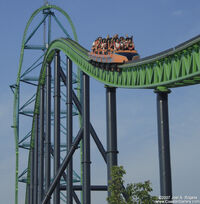The train arrives at the station after its mile-long journey, and the passengers unload. As everyone files off the train, they chat excitedly about their wild experience. The train had just sped over 5,312 feet (1619.1 meters) of twisted track at over 80 miles per hour (136.8 km/h), and reached a height of 245 feet (74.7 meters). This is a roller coaster, specifically, Titan at Six Flags Over Texas. Titan, like hundreds of others, is a thrilling roller coaster ride. Millions of people ride roller coasters like this, and even bigger ones, for the exciting rush of adrenaline, and the heart-pounding height and speed that these thrill rides offer. Because of the danger that roller coasters seem to present, some members of the United States government would like to enforce a limit on the amount of g-force caused by roller coasters.[1] Despite the dangerous-sounding statistics of roller coasters, a g-force limit does not need to be implemented by the United States government.
A g-force limit is not needed because roller coasters are already statistically among the safest recreational activities. According to the Amusement Safety Organization, roller coasters have caused 30 injuries in 2010, and 2 fatalities.[2] Out of those injuries, 28 of them were not serious enough to necessitate a hospital visit. As a comparison, in just one year, 1,200,000 injuries were caused by American Football, and 55 people died while fishing, while biking caused 500,000 injuries, and 700 deaths.[3] It would be unreasonable to force regulations onto roller coasters when there are so many other dangerous, yet unregulated activities.
G-forces are already kept under control, even in the tallest and fastest roller coasters. Supporters of the g-force limit worry that as thrill rides continue to be built taller and faster, the g-forces are increasing to deadly levels.[4] Although it is true that roller coasters continue to increase in size, g-forces have, in fact, remained at safe levels. The last coaster to break the g-force record was Tower of Terror at Gold Reef City in South Africa, which tops out at 6.3G, yet only rises to one fourth the height of the tallest coaster in the world, Kingda Ka. Kingda Ka, reaches a height of 456 feet (139 meters) and a top speed of 128 mph (206 km/h) while pulling a maximum of 5G. What causes g-force is not simply height or speed; it is an element such as a sharp turn, or a small loop in which riders change directions suddenly.[5] If a designer wanted to design a ride that is taller and faster, he would simply make larger turns to make up for the added speed. Height, speed, and g-forces can all be tamed with careful designing, not with laws imposed by the government.

Maverick Defunct Heartline Roll
Maverick's defunct heartline roll.
Another reason not to impose the limit is that roller coaster designers are not selling deadly designs, even though there are no limits. Roller coaster designers are paid for creating imaginative designs that are then marketed and sold to theme parks around the world. The amusement parks spend several weeks just testing the ride in all kinds of situations in order to make sure that their guests will remain safe. If a problem is found, the park consults with the manufacturer and redesigns the problematic areas. One notable example of this happening is with Maverick at Cedar Point in Sandusky, Ohio.[6] The original design was to include an element known as a “heartline roll” mid-ride, but during testing, Cedar Point found that too much stress was exerted on the trains, and the segment of track may have been uncomfortable for riders. The manufacturer, Intamin AG, promptly manufactured and replaced the section of track. The ride passed the tests, and is now open to the public. This is a perfect example of how theme parks and coaster designers collaborate to keep their customers safe. Roller coaster designers wouldn’t design deadly designs because theme parks simply wouldn’t buy them.
Proponents of this g-force limit claim that roller coasters are dangerous because the forces exceed those experienced in space shuttles.[7] While that is true for many roller coasters, there is actually more than meets the eye. When a space shuttle is landing, it will typically pull 2.5G, meaning that the passengers are feeling more than twice their regular weight.[8] To prepare for this physically straining activity, astronauts go through intense training to become fit enough to handle the forces. Roller coasters typically pull 3 to 4G during the average ride.[9] Other than meeting the height and weight requirements, nothing else is required of the potential riders. How then, is this at all safe for ordinary people? There is one major difference that is often overlooked. Astronauts, during the landing of a space shuttle, have to deal with great g-forces for close to ten minutes. The problem with g-forces is that they pull the blood out of the head, into lower parts of the body, and eventually could cause a blackout. When roller coasters are exposing riders to these forces, it is typically for only two to three seconds, meaning that there is not enough time for the blood to drain from the passengers’ heads. This claim by the proponents is very misleading.
Roller coasters have been around for decades, growing bigger and better, yet never more dangerous. Because the theme park industry already regulates itself, through careful designing and testing, the United States government does not need to regulate the g-forces on roller coasters.
References[]
- ↑ http://www.cbsnews.com/stories/2002/06/25/earlyshow/living/parenting/main513414.shtml
- ↑ http://www.amusementsafety.org/safety_news_10.asp
- ↑ http://www.cdc.gov/HomeandRecreationalSafety/bikeinjuries.html
- ↑ http://www.cbsnews.com/stories/2002/06/25/earlyshow/living/parenting/main513414.shtml
- ↑ http://www.iaapa.org/industry/funworld/2003/Mar03/Features/G%20Forces/G%20Forces.html
- ↑ http://www.crainscleveland.com/apps/pbcs.dll/article?AID=/20070508/FREE/70508011/1096&Profile=1096
- ↑ http://markey.house.gov/index.php?option=com_issues&task=view_issue&issue=44&parent=14&Itemid=174
- ↑ http://abyss.uoregon.edu/~js/space/lectures/lec17.html
- ↑ http://www.sos.siena.edu/physics/files/pdf/Coaster%20Safety.pdf




